Jeremie Averous's Blog, page 145
September 29, 2012
Why the Fourth Revolution is the Era of the Exponential, and How this Changes Everything
The Fourth Revolution is the era of the exponential – whereas the Industrial Age was the era of linearity. And that changes everything in the way we live our life:
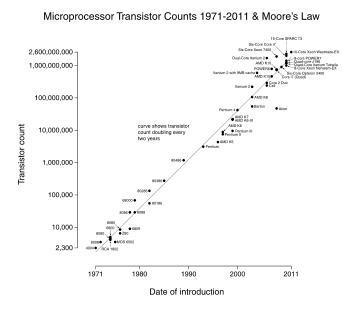
Moore’s Law 1971-2011 (from Wikipedia)
the complexity of the products we use every day increases exponentially. For example the Moore’s law states that microprocessors density on chips doubles every 2 years; and that’s the case for many other products we use every day without realizing it;
Successful companies and services grow exponentially, soon dwarfing existing players (the revenue of Apple was multiplied by 11 in 10 years… not to mention the even more exponential growth of the Facebooks of the world)
In the Industrial Age, things were more linear. It was easier to extrapolate the future from the past. Of course a factor is that things go faster today so that it is easier to watch exponential change in action. Yet the Moore’s law rate did not change in the past 40 years or so. Microprocessors’s density still double in the same number of years. So speed of change is not the discriminant. The fact that things grow visibly exponentially and have higher ceilings than before makes the Fourth Revolution different.

Are you sure you want to get to the end of the chessboard?
The problem is that we are not geared to feel intuitively the power of the exponential. It is very difficult to seize how fast it can grow. Do you remember the tale of the wise man that told the King who wanted to thank him: “only put a grain of rice on the first square of a chess board, then on the next square put two, then on the next square put four, then double for each square until the end of the chess board…” The King never realized that at the end of the 64 squares the quantity of rice needed would vastly exceed his available supply – and the world’s supply and even more!
This explains why so many people today have difficulty understanding what happens in the world. In their linear Industrial Age mindset, they can’t grab how the exponential is changing our lives faster and deeper than ever before.
Are you ready for a world full of exponential change?
Thanks to Mitch Joel and his post on “The Era of Exponential Marketing” – a specific area where most people also don’t realize we are in for exponential growth of product sales- for the inspiration.
The great picture of the rice on the checkboard is by Paul Starkey on Flickr.

September 27, 2012
Publishing A Book is Not Any More a One-Way Broadcast
If you are a e-book reader you might have noticed that you can type in your notes and share your text highlights with other readers, the world… and the publisher.
Publishing a book is not any more a one-way broadcast. And the role of the distributors has increased dramatically. Since a decade, readers can easily speak their mind on all books on most e-bookshops (the distributors) – which in effect is a sort of crowdsourcing of opinions. I now look at who recommends the book and what the opinions of readers are before buying.

Ebooks add a layer of interaction and can spread your notes and highlights
Now an other layer of feedback has been added with e-books. Distributors like Amazon or Barnes & Noble can also get feedback from the inside of the book when you read them. On most e-book reading devices you can take notes and highlight quotes – and share them with the wider community – and the publisher.
This paper in the Wall Steet Journal, “Your E-book is Reading You” explains that the distributors have only started analyzing that huge pile of data.
And because of this huge trove of data, and the insights that will be derived from what the readers like or don’t like, the power of the Publisher will vanish while the power of the Distributor will soar – and we can predict that soon Publishers will be taken over by Distributors, like Amazon is already doing.
Publishing books started the Industrial Revolution, the era of Broadcasting. Today, publishing books enters the Collaborative Age in full, allowing almost real-time interaction with the readers. And as with other industries, publishing will be put upside down by the Fourth Revolution.

September 25, 2012
Old Industrial Age Cliches Die Hard. Kill them Faster to Transform the Economy!
As I was travelling in France a few weeks ago I was repeatedly struck by how Old Industrial Age cliches die hard – and in particular in ‘developed’ countries.

Lets’ Reindustrialize France (2012 French trade union poster)
Trade unions claim that the country should be re-industrialized (poster on the right I saw on a building). That would be fine if they did not mean rebuilt large manufacturing complexes.
Authorities and traffic forecasters still believe that people take their leave all together when the factories close (which is of course, less and less true – no wonder traffic predictions are less and less accurate!).
In the midst of the crisis, the government plays with the idea of creating large manufacturing giants, the key to wealth and prosperity. Is it really?
I have two main objections to this:
First, in the Fourth Revolution, as argued repeatedly in this blog, a nation wealth and prosperity will not come from its manufacturing proficiency, but from its creativity, networking and knowledge enhancement capabilities. There will always be cheaper places to manufacture. There won’t be so many places to create value.
Second, frankly after I spent as a student a one-month experience in a car manufacturing plant, I don’t see working in a manufacturing environment as the dream of my life where I would encounter the development opportunities I dream of! So I don’t necessarily wish this to be the future of the entire next generation.
Diving into the Fourth Revolution is not easy. It is not easy at a personal level because instead of waiting for someone to give instructions we need to find out how to create value for others. It requires to change one’s mindset.
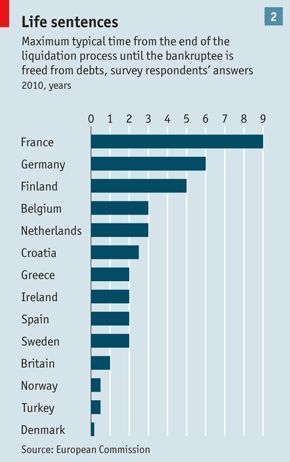
Durations of bankruptcy by country (the Economist)
But it is not by dreaming of rebuilding smoking stacks of large manufacturing plants that the economy of developed countries will be saved. It is by releasing the creativity potential of the people!
One of the best papers I read on that lately was from the Economist, “les Miserables“, or how Europe consistently discourages entrepreneurs (published July 2012).
Do you really release the potential of your people when they get a life sentence when they fail (see the graphic on the average duration of bankruptcy)? Do you think they will take the risk to fail – a risk inherent to any creation?
Stop dreaming about going back in time to the Industrial Age. Step forward into the Fourth Revolution or you’re doomed.
Allow people to fail. Allow people to be flexible with their life. Create the infrastructures and institutions that will free people while giving them a guaranteed minimum safety net at a reasonable price.
The opportunity is now. Crisis are time where things can change, where things will shift. The current crisis might be the one opportunity for developed country to do the transition. Don’t miss it.

September 22, 2012
Are you weird enough?
“Weird (not normal) means that you’ve made a choice, that you’ve stood up for what you believe in and done what you want” – Seth Godin in ‘We are all weird‘

A weird book: on the left, the official cover; on the right, the weird cover (a picture of a swami, an ascetic yogi – the “weird” archetype)
Seth clearly means that if today you want to make your mark in the world, well… yes, you certainly need to be weird. And not just a bit weird. VERY weird!
It’s time to take initiative, stop being confused with the other guys, be really yourself.
I know I am not weird enough sometimes – although I do more and more stand up to what I believe.
And you, are you weird enough to thrive through the Fourth Revolution?

September 20, 2012
Do you have enough quiet time with yourself?
“Others inspire us, information feeds us, practice improves our performance, but we need quiet time to figure things out, to emerge with new discoveries, to unearth original answers” – Dr Ester Buchholz (from Garr Reynolds’s ‘Presentation Zen‘ (a great recommended book to improve presentation skills!))
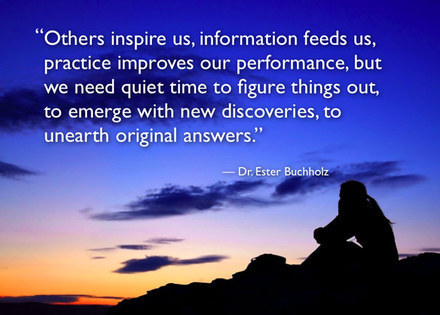 As modern life pushes us around, tries to keep us busy constantly, do we still have enough time to stop receiving all this information and figure things out?
As modern life pushes us around, tries to keep us busy constantly, do we still have enough time to stop receiving all this information and figure things out?
In fact it is all about balance: we do need the contact with the others to receive other view points, open our minds, discover the world, know how other people have failed, sound solutions, what they have learned. And we also need to have some time to be with ourselves, let our creative mind reveal itself and create.
What should the ideal balance be like? Probably lots of interaction with the world and just making sure we keep enough time to be alone with ourselves.
Do preserve this precious time alone with yourselves. be it meditating, walking, looking through the window of the train… It’s worth it. It’s needed. For you. For your contribution to the world. Do it. Now.

September 18, 2012
Why the Collaborative Age is about Lean – Accelerating our Learning
Have you read the ‘The Lean Startup: How Today’s Entrepreneurs Use Continuous Innovation to Create Radically Successful Businesses ‘ by Eric Ries? I must say I was a bit reluctant at first because it seemed to be a very trendy flashy concept – of the kind that are trendy for a season and then disappear in the forgotten-great-concepts-that-were-supposed-to-change-the-world.
‘ by Eric Ries? I must say I was a bit reluctant at first because it seemed to be a very trendy flashy concept – of the kind that are trendy for a season and then disappear in the forgotten-great-concepts-that-were-supposed-to-change-the-world.
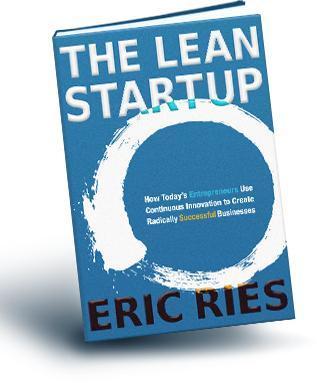 Pushed by my curiosity I still read it and I must say that I dived into it. Because what Eric Ries is describing there in the realm of startups can probably be applicable to all types of endeavors in the Collaborative Age. An Age where failure does not cost a lot, and where on can try multiple ideas without committing too much funds or time. An Age where learning from actual feedback can be dramatically accelerated.
Pushed by my curiosity I still read it and I must say that I dived into it. Because what Eric Ries is describing there in the realm of startups can probably be applicable to all types of endeavors in the Collaborative Age. An Age where failure does not cost a lot, and where on can try multiple ideas without committing too much funds or time. An Age where learning from actual feedback can be dramatically accelerated.
The Lean Startup proposes a structured framework to accelerate Learning. It proposes to propose to the world a ‘Minimum Viable Product’ as soon as possible, listen to the feedback, and accelerate the learning curve. Most people and companies do the mistake of taking long time to develop the ‘perfect product’ – that nobody really wants, because we never asked the potential user!
You might also have heard about ‘pivoting’ in the context of startups: it is about deciding to change completely the plans and the business model to respond to the actual feedback. And most successful startups need to pivot once or twice. Hopefully they can do it before they reach the end of the cash runway! Lean enables companies to learn quicker what works and what does not work.
Read the book or watch this video. It’s worth it!
Get Lean, and accelerate your learning. Stop perfecting your product, throw your ’Minimum Viable Product’ to the world!

September 17, 2012
Large, Complex Projects: Discover the slides from my latest public presentation
I had the opportunity to do a public presentation about large, complex projects last week in Kuala Lumpur. There are no video recordings available but here are at least the slides.
Large Complex Projects (PMI-MY presentation Sept 2012) from ProjectValueDelivery
Enjoy!

September 15, 2012
Crowdfunding is not charity – and it is not free!
Crowdfunding is very trendy. It is about financing startups with many people contributing a little bit of money each (it also works very well in other endeavors like political campaign financing and art financing).
We’ve already touched on crowdfunding in the posts “What’s hiding behind crowdfunding sites” which mentioned Kickstarter, the most famous crowdfunding site, and how these sites are effectively crowd-voting machines; and how crowdfunding applies to small local business as well “Crowdfunding… a local bakery“.
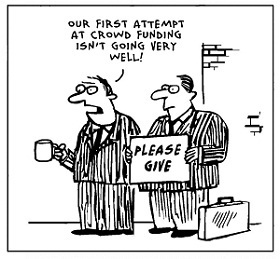
Crowdfunding is not charity!
Recently there have been efforts made by the US government to give a legal framework to crowdfunding, although that is still work in progress as the issue is quite complicated (the JOBS act was signed by President Obama and gives 9 months for the SEC to come up with regulations). More information in this Forbes article.
While the regulatory landscape might change deeply, the crowdfunding model also becomes clearer. It is not ideal for everybody as a funding mechanism. And it is more and more obvious that being successful at crowdfunding requires a well thought strategy and plan.
There is one commonality to this plan: you need to give back value to the investor. No, crowdfunding is not free! It is not charity! Investors want something back from their initial investment; and generally they do want good value perks. This excellent paper on a jeans manufacturing startup that has used crowdfunding successfully gives very good advice on what it takes. Basically, investors are paying money in advance for getting your product later as a perk, or to get a special treatment of some sort. There is a fine line between pre-sales and crowdfunding, although crowdfunding perks can also be more flexible.
Crowdfunding is not just generous benefactors giving for free: for them, it is an investment that needs to get a good return in terms of value. If you seek crowdfunding, what future value can you promise to the investors that will more than enough compensate for their money?

September 13, 2012
Avoid the entrepreneur trap: go and meet your clients!
As an entrepreneur with a vision, a very clear trap is to develop an idea of the business without asking the ultimate stakeholder: the client.
It is so easy to fall into this well-known trap of not listening enough to clients – because setting up a company involves already so much energy and focus on getting it to run, on developing products, on setting up the necessary organization and infrastructure, that it is easy to forget to check what the clients really want.

What do you get from client visits?
Yet every time I go and visit prospects and clients I come back with new insights about what they really want, on the fact that some of our own projects are not really what they expect, and many different inputs that can feed into the future development of the company and its products.
It is sometimes difficult – because what you thought were bright ideas do not meet any resonance.
It is sometimes exhilarating as the discussion allowed you to see a practical solution to a need, creating a way to fulfill your vision
It is sometimes disturbing because what you heard is very different from what you thought.
Yes, it can be difficult, exhilarating and disturbing – but visiting and listening to clients is always worthwhile.
Make sure that you spend enough time confronting reality by looking through the eyes of your prospects and clients! When do you start?

September 11, 2012
A visual demonstration of the revolution in manufacturing
Digital manufacturing, also known as 3-D printing (see our April 2011 post on 3D printing), is a technology that is evolving into an industrial production technology. It now allows to produce objects that are far more evolved and cheaper that those that could be produced by conventional manufacturing processes – and one customized piece at a time.
Not convinced? Just watch this 3 minutes video. It says it all and demonstrates one of the most complex and customized products that is manufactured: a prosthetic leg. Enjoy!
Here is the link if you can’t see the video above. Enjoy!




